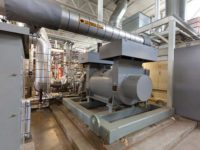Ford is in the midst of a massive renovation and upgrade project at its Dearborn, Michigan, campus. The 10-year transformation initiative targets a reduction in annual energy consumption by up to 50%. Construction of the Central Energy Plant (CEP) is underway to replace aging on-site boilers. The various elements of the CEP are a 34-MW and 370 k-lb./hr. steam combined heat and power (CHP) system, solar power arrays, a 16,000-ton chiller system, a 156-MMBtu/hr. hot water supply system, a 6,400 ton geothermal system, 40,000 ton-hr. of chilled water storage, and an energy distribution system.
“This new CHP facility will provide both steam and electric power,” said Michael Larson, director of business development, DTE Energy Services. “It increases the efficiency of the grid, lowers emissions, and improves the cost equation for both Ford and DTE Energy Services.”
Ford originally specified a small CHP plant with two Solar Mars 100 gas turbines and a 3-MW condensing steam turbine for a total of 23 MW. However, the planned CHP facility would suffer from a relatively low capacity factor and low efficiency. A larger CHP facility was therefore proposed by DTE, consisting of two 14.5-MW Solar Titan 130 gas turbines, a 5-MW condensing steam turbine from Siemens, and Rentech Heat Recovery Steam Generators (HRSGs) (370,000 lb./hr.). It offers a higher capacity factor and greater efficiency, enough steam load for Ford, and optimized sizing to provide electricity for the grid. It will use 10 times less natural gas than a traditional boiler plant.
The Dearborn HRSGs are high-fired waterwall, O-type HRSGs that include supplemental-firing and fresh air-firing capability, along with diverter and space for future SCR catalyst if ever required. By raising the gas turbine exhaust temperature via supplemental firing, steam production is increased by approximately 300% from an expected unfired rate of 63,000 pounds per hour (pph) to 185,000 pph per unit.
“Rentech HRSGs were selected based on life cycle costs, including unfired and fired steam output, capital cost, and O&M cost,” said Larson.
Fresh air firing is the addition of a forced draft fan that allows the plant to run the HRSG when the gas turbine is offline. The fan draws in ambient air from the atmosphere, and the duct burner adds all the required heat input to create the steam required. This means that even if the gas turbines are offline for maintenance, Ford can still receive 80,000 pph of steam per HRSG.
The firing temperature of the furnace will be around 2,000°F. Due to this, the unit is constructed of a membrane wall made up of tubes that connect to the steam and mud drum. This allows naturally circulating water to keep the unit cool. The steam drum is situated directly over the mud drum and shares the same centerline.
The CHP plant also includes a diverter. This is a large louver-type valve between the HRSG and the turbine. If the plant does not need steam but has an electrical requirement, the flue gas from the turbine can be diverted up a bypass stack and not through the HRSG. Thus, electricity is generated and not steam.
“We worked closely with the owner’s engineer and DTE Energy Services throughout the development, bidding, and procurement process, supplying HRSG process and mechanical information to help them determine which turbine and HRSG best fit this application,” said Andrew Guillen, heat recovery applications engineer at Rentech.
Steam and hot water from the CHP plant will primarily be used for heating as well as personnel and building comfort. A very small portion of the steam and hot water will be used for some processes within Ford.
“One-hundred percent of the net power from the CHP facility will be available to DTE Electric customers minus the auxiliary power consumed within the CHP facility of around 500 kW,” said Larson.
Construction began in the latter part of 2018 and is scheduled to be completed by the end of 2019.





